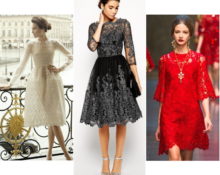 The variety of guipure is enormous: printed, plain-dyed, elastic, knitted, with lurex and sequins. This small master class will help you sew a dress from guipure.
The variety of guipure is enormous: printed, plain-dyed, elastic, knitted, with lurex and sequins. This small master class will help you sew a dress from guipure.
Selection of material and product model
The process of making a dress begins with the choice of fabric. The range of colors of guipure is amazing. It is used as the main fabric.
Dresses made of guipure are sewn with a lining, which is chosen so that the lace pattern is clearly visible. It should be darker, lighter or a contrasting color. Use satin, satin or silk.
The model is chosen to have a simple design so that darts and seams do not disturb the design. If guipure is not elastic, fitted silhouettes will not work.
Required Tools
- Scissors
- Safety pins
- Chalk or soap
- Needle
- Threads
- Sewing machine
- Overlock
- Pattern
- Tape measure
- Ruler
Pattern and Cutting
All patterns are made according to measurements taken from the figure or translated from fashion magazines and adjusted to the desired size.
The finished pattern is placed on the wrong side of the lining fabric, secured with pins and outlined. Allowances for straight cuts – 1 cm, for neckline and armhole – 0.5 cm. It's being cut out. This process is repeated with guipure. The most advantageous design motifs are used. All cut details are placed on the fabric and only then cut out. All chalk lines are transferred to the other side. Having done the preparation, we move on to the next stage of work, sewing the dress.
Work progress
Guipure material is difficult to process, so the process requires a certain skill and knowledge. The seam allowance sections are overlocked with an overlocker, processed with bias tape or cut along the contour and overlapped, and then secured with a zigzag stitch or manually. You can also use a reverse stitch: the seams are sewn along the front side, and then along the back. In dresses with sleeves, the armhole is also processed using this method.
All darts and seams must be basted on the main and lining fabrics. A sheet of paper is placed between the product and the material feed mechanism to protect the thin fabric from tearing. Seam width when sewing – 0.5 cm. To sew a fashionable dress with your own hands, you need to use fine sewing needles No. 75 and silk threads, and for stretchable guipure - needles for knitwear.
The neckline and bottom of the product are finished with a figured edge or silk lace ribbon. Elastic guipure requires different handling - check your material for stretchability; if it stretches well, then it is better to use cotton tape to strengthen it.
The zipper is inserted into the middle or side seam, depending on the chosen style of the product. The edges of the zipper are edged with a seam allowance or bias tape.
Lining
You can use three different methods to create a lining for a guipure dress.
- It is made as an independent dress, removable - not attached to the main fabric, used with other dresses.
- The lining and base are sewn as a single unit. A basting is placed in the center of the back and front. Side and shoulder seams are sewn. The bottom of the product is folded together with the lining. The bottom of the lining can be shorter than the main product, then it is processed before sewing the side seam.
- Along the neckline the lining is attached to the base. The side and shoulder seams are pre-stitched. The right side of the lining is placed on the right side of the main fabric and hemmed. The cut is cut at regular intervals, not reaching the machine stitching 0.1 cm. The seam allowances are folded over the lining and stitched.
You can also make a beautiful two-color lining, then the model takes on the appearance of a skirt and blouse.
It is very important to iron the lace at a low temperature using an ironing iron (a piece of white cotton fabric) to avoid damaging the lace.
Conclusion
Guipure is a rather complex material that requires certain skills in handling it. The experience gained will be useful for subsequent work: decorating any dresses with lace inserts, to your own taste, and creating unusual models. It is recommended to save the patterns, as they may be needed in the future to create other models.




 0
0





